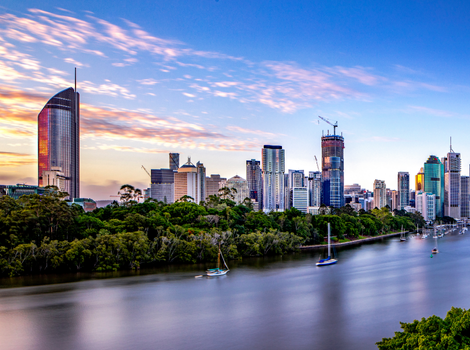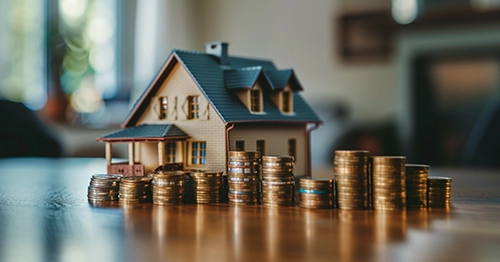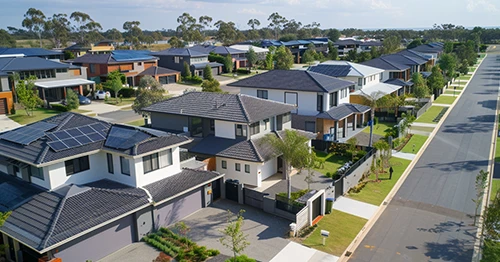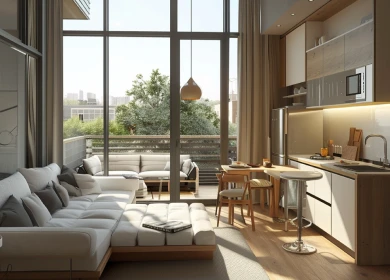Updated: 29 May, 2025
Table of Contents
Here’s what the 2022-25 Australian Housing Outlook commissioned by QBE forecasts will happen to Australia’s property market over the next three years:
- The housing market slowdown that Australia is experiencing now will be widespread but vary among states and territories. Sydney will be the most susceptible to rising borrowing costs and could experience the largest decline.
- The tightening of credit availability will drag the residential market. The Reserve Bank of Australia has said there could be further cash rate increases well into 2023.
- Borrowers are choosing fixed-rate home loans due to rising interest rates and expectations of tighter monetary policy. The fall in borrowing capacity could drag on buyers’ ability to bid up property prices.
- The steepest falls in dwelling prices could happen over the next six months. In late 2023, Australia’s housing market is set to mark the bottom of the property cycle. Prices will recover after bottoming out, as borrowing costs stabilise.
- Unit prices experienced modest growth over the last two years and are forecast to decline less than houses. Due to this recent price disparity, unit prices are less exposed to affordability issues.
- The unit sector will be supported by the transition to hybrid working arrangements, as working from home has boosted demand for larger dwellings.
- Investors will be active in the market due to strong rental yield growth, which is set to be sustained by the return of overseas migration.
You can download a PDF of QBE’s 2022-25 Housing Market Outlook here.
Let’s take a closer look at what will happen in each capital city of Australia over the next three years.
| Sydney | Melbourne | Brisbane | Perth | Adelaide | Hobart | Canberra | Darwin | |
|---|---|---|---|---|---|---|---|---|
| Median house price at June 2022 | $1,531,100 | $1,059,600 | $864,300 | $664,800 | $717,600 | $811,000 | $1,019,300 | $627,200 |
| Forecast median house price growth 2022-2025 | -8.2% | -6.0% | -5.3% | 2.1% | -6.0% | -4.3% | -2.3% | 3.2% |
| Median unit price at June 2022 | $850,00 | $649,500 | $505,000 | $435,600 | $462,500 | $650,900 | $605,600 | $388,200 |
| Forecast median unit price growth 2022-2025 | -0.1% | -0.4% | 0.4% | 5.3% | 1.1% | -2.4% | 3.6% | 6.1% |
Source: QBE’s Australian Housing Outlook 2022-2025
Sydney Property Market Forecast
- NSW is now on a downward swing after its recent boom. Prices began to fall in April 2022. As of June 2022, the median house price in Sydney was $1,531,000.
- Sydney has a high level of household debt, which makes it most susceptible to rising interest rates and tighter lending conditions.
- Its median house prices are expected to record the greatest peak-to-trough decline – 18% from their peak.
- Soft growth could return in late 2023, supported by the state’s stamp duty reform.
- The median house price is expected to reach $1,405,000 in the June 2025 quarter.
- As borders reopened, Sydney’s rental market recovered swiftly from the fall in demand during the pandemic. Unit rents could increase by 15% in 2022-23, and houses could increase by 13% in the same year.
- There are expectations of more robust rental growth for units than houses over the two years to 2024-25. Strong growth in rents will support investor demand.
- Regional NSW remained buoyant due to affordability and preferences for working from home. There will be a more even distribution of population growth in 2024-25, which will benefit demand in locations like Newcastle and Wollongong.
Melbourne Property Market Forecast
- House prices in Melbourne fell by 2.2% during the June 2022 quarter, and the median price was $1,060,000.
- The weak demand resulted in an oversupply of stock in 2021-22. As oversupply will keep growing in 2023, the recent interest rate rises will continue to drag on prices.
- The median house price could be $995,000 by 2025.
- Rental vacancy rates are tightening in inner Melbourne. Unit rents are expected to recover the losses sustained during the pandemic by December 2022. As borders reopen and international students return, Victoria’s population growth will bounce back to 1.5% by 2022-23.
- There will be a rise in dwelling construction aided by the state’s ‘Big Housing Build’ and build-to-rent investment.
- Melbourne’s median unit price is set to hit bottom in 2023, then rebound to around $647,000 by June 2025.
- Work-from-home preferences will allow regions like Geelong, Bendigo and Ballarat to experience population growth on par with capital cities.
Brisbane’s Property Market Forecast
- Brisbane was the strongest performer in the country in 2021, as its median prices increased 32% over the year, compared with 22% nationally.
- The robust growth was due to an influx of interstate migration from southern states over the past two years, which caused a shortage of dwelling stock.
- Brisbane was affordable, compared with Sydney and Melbourne, with a median house price of $864,000 in June 2022.
- In the next three years, Brisbane’s strong population growth, affordability and demand relative to the amount of dwelling stock will help it outperform other cities.
- The tightened credit conditions will lower borrowing capacities and crimp affordability.
- Brisbane’s house price in 2024-25 could be $819,000 in June 2025.
- Queensland’s unit prices outperformed, with a rise of around 13% in 2021-22, compared with 3% nationally. The median unit price was $505,000 in June 2022.
- Investors flocked back in 2022, in response to strong rent growth, which led to a four-fold increase in investor lending in Queensland in two years.
- Migrating young families and changes to household formations tightened rental markets in Brisbane. As of June 2022, Brisbane had a rental vacancy rate of 0.97%, the lowest recorded since March 1988.
- In the next three years, to June 2025, unit rents are forecast to grow by a further 19%.
- The median unit price is forecast to be $507,000 in June 2025, after reaching a mild trough in late 2023.
Perth Property Market Forecast
- Through 2022, the pace of growth picked up, and Perth’s median house price was estimated to have grown 10% in 2021-22, to $665,000 in June 2022.
- The reopening of domestic and international borders, greater housing affordability, a strong mining sector, a strong jobs market, and available stock supported Perth’s property market resurgence.
- A rise in house prices of 4% in 2024-25 could see the median house price reach $679,000 in June 2025.
- Western Australia’s return to net overseas migration inflow is set to contribute to population growth. The significant temporary population that makes up the mining sector in Perth is a key driver of rental demand and growth in the unit market.
- In 2019, Perth was reclassified as a regional location for migration purposes, which could mean an increase in the share of student migration.
- Over 2021-22, Perth’s median unit price rose 3%, to $436,000, and the market is expected to avoid the downward trend in dwelling prices next year.
- The completion of the new Metro net links and social infrastructure in Perth CBD could draw out strong growth.
- The median price is forecast to reach $459,000 in June 2025.
Adelaide Property Market Forecast
- An uncharacteristic migration inflow from interstate, low supply, and housing affordability have fuelled Adelaide’s price growth over the last two years.
- The median house price broke through the $700,000 mark and reached $718,000 for the first time in June 2022 – 42% higher than in June 2020.
- Over the next three years, the positives for Adelaide’s housing market might not disappear. However, the demand boost from net interstate migration will fade over time. As construction projects are completed, new dwelling supply will increase.
- The median house price in Adelaide is past the peak and could recede 6% over the coming three years, to $676,000 by June 2025.
- Adelaide experienced a unit price growth of 11% over 2021-22, and its median unit price reached $462,000 in June 2022.
- The acceleration of growth in rents, which increased 9% for units in 2021-22, has encouraged investor optimism.
- Rents are forecast to rise by about 17% for units in the three years to June 2025. With unit prices expected to show resilience, the median price is expected to be $468,000 at that time.
Hobart Property Market Forecast
- Over the last two years, a tight and persistent dwelling deficiency and housing stimulus have underpinned strong house price growth.
- A sharp rise in property listings dragged growth, with prices expected to have peaked at $811,000 in the June 2022 quarter.
- Despite the deceleration in momentum, the median house price lifted 19% in Hobart over 2021-22. The city is expected to become Australia’s third most unaffordable market.
- The stretched housing affordability makes this market particularly sensitive to interest rate moves but undersupply counters that some. The median house price is forecast to fall by around 8% in 2022-23, to $776,000, in June 2025.
- Hobart has already experienced strong gains in rental prices, reflecting the tight rental vacancy conditions. The median unit price rose 11% in the past year, to $651,000 in June 2022.
- Unit prices are expected to decline to a trough of around $610,000 in late 2023 before rising to $636,000 in June 2025.
Canberra Property Market Forecast
- The median house price in Canberra eclipsed the $1 million mark in March 2022, making it the third most expensive capital city in Australia.
- The momentum for house prices slowed, but growth of 14% was recorded over 2021-22, which took the median house price to $1,019,000 in June 2022.
- Affordability is not a big concern in Canberra, as its average household income is higher than elsewhere in Australia. Still, the cash rate rise will affect borrowing power, worsen affordability and drag property prices.
- In the next three years, new dwelling supply will balance stock availability. The median house prices are expected to fall 9% in the next 18 months, before rising to $996,000 by June 2025.
- Canberra experienced solid growth in its unit market due to high incomes, dwelling undersupply, and falling listings. In 2022, the median unit price was $606,000.
- By 2025, median unit prices will rise to $627,000 due to strong overseas migration and new construction geared towards apartments.
Darwin Property Market Forecast
- Darwin’s median house price grew 30% over 2020-21, then rose a further 5% in 2021-22, bringing the median house price to $627,000 in June 2022.
- Even with the strong rebound, Darwin remains one of Australia’s most affordable capital cities.
- Darwin could experience population inflows encouraged by major investments in resources and defence. The Barossa LNG project could prop up demand during construction, and non-residential development could create greater job opportunities.
- In the next three years, further price falls could be limited. The median house price is expected to grow in the next two years, taking it to $647,000 by June 2025.
- Unit prices in Darwin are expected to hold firm as tourism returns, employment prospects improve, and dwelling oversupply erodes. A high gross rental yield of 6% is enticing investors.
- Darwin’s unit prices are expected to outpace house price growth. The median unit price is expected to increase to $412,000 by June 2025.
Making Green Property Choices
- Australia has the world’s highest proportion of households with uptake of rooftop solar energy. As of June 2022, there were nearly 3.2 million installations – about 30% of all homes. Installing a 5kW rooftop solar system saves an average Australian $909 yearly on electricity.
- Research suggests that installing solar systems adds value to the price and rental value of the property. Renters with rooftop solar panels pay $19 more, on average, in weekly rent.
- New homes could be constructed with greater insulation, double-glazed windows and lighter-coloured roofs to reduce future household emissions. The transition to green housing was accelerated at the meeting of the Building Ministers, which resulted in a mandated 7-star minimum Nationwide House Energy Rating Scheme (NatHERS) rating.
- Sustainable housing could add value to a property. Energy-efficient homes could be worth 5-10% more than comparable homes that are not.
- Households are adopting more energy-efficient appliances, heating and lighting solutions.
- Energy retailers offer renewable and carbon-offset products for environmentally conscious customers.
- Lenders have started to offer green home loans to encourage sustainable housing. They are also offering personal loans at discounted rates to retrofit green appliances, add rooftop solar systems and make other green upgrades.
Over the next three years, investors can set their eyes on a strong unit market for some capital cities. While homebuyers could rejoice at the fall in house prices, tighter credit conditions could still make getting approved for a home loan difficult.
At Home Loan Experts, our mortgage brokers can help you throughout your home-buying or property investment journey. Call us on 1300 889 743 or enquire for free online.







